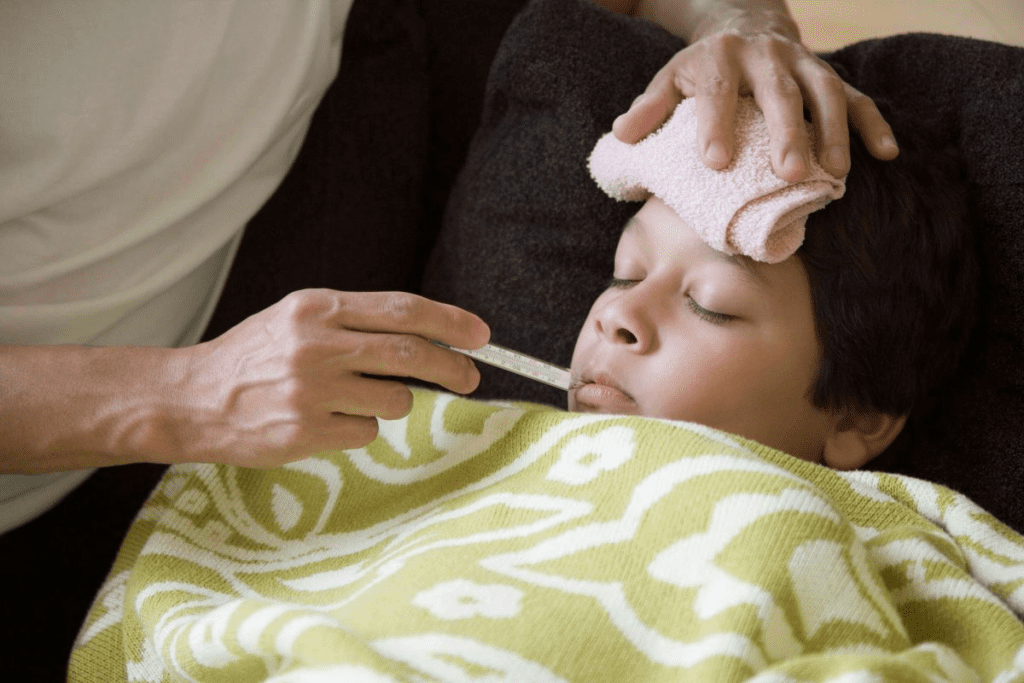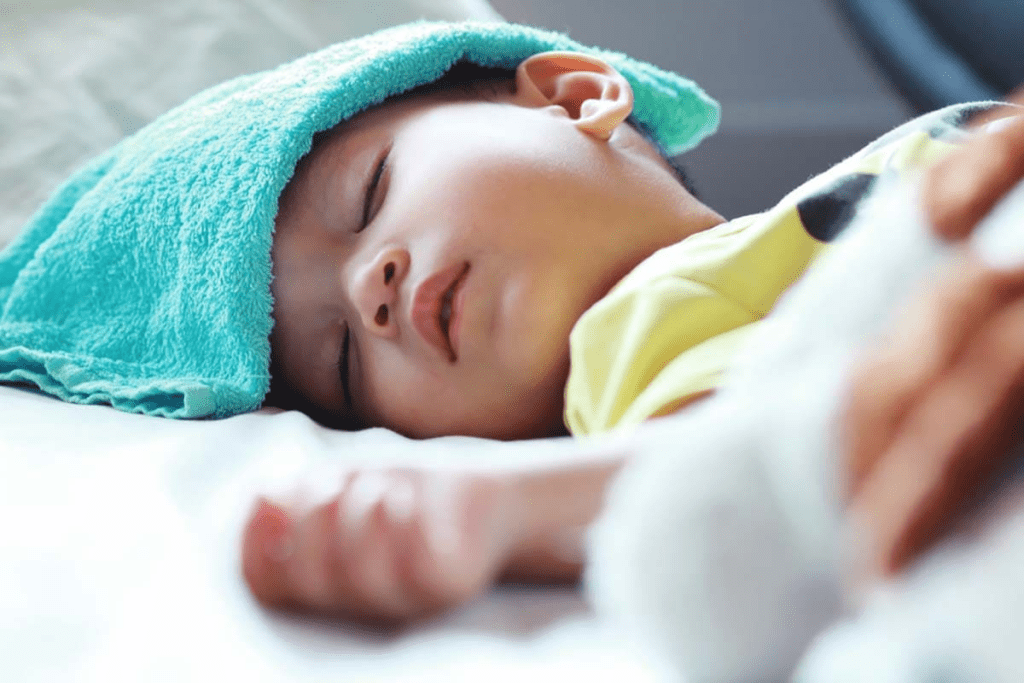Last Updated on November 20, 2025 by Ilayda Cengizhan
When a child’s fever goes up, parents look for fast and safe ways to help. Knowing whats the temperature and how to manage fever is key for every caregiver.

The quickest way to lower a child’s fever is with acetaminophen or ibuprofen. These medicines can drop body temperature in 30“60 minutes. Studies show that acetaminophen (10“15 mg/kg every 4“6 hours) or ibuprofen (5“10 mg/kg every 6“8 hours) are best for kids over six months.
It’s vital to stick to the right dose to keep the child safe. Knowing if 100 is a fever helps decide when to give medicine.
Fever is a natural response to infection in children. Knowing this can help parents make better choices. A fever is when the body temperature goes over 38 °C (100.4 °F). Normal body temperature is between 36.5 °C and 37.5 °C (97.7 °F to 99.5 °F).

Body temperature can vary from child to child. It’s important to understand these differences to know if a child is sick.
Temperature ranges change with age. For example, infants have less stable body temperatures than older kids. Knowing these ranges helps parents spot when their child has a high temperature.
Fever is not just a symptom; it’s a natural defence. When a child has a fever, it means their body is fighting an infection. Understanding that fever is a natural defence mechanism helps parents manage their child’s condition better.
Studies show that fever helps the body fight off infections. It makes it harder for some pathogens to grow. But it’s important to watch the fever and get medical help if it gets too high or if other symptoms appear.
Parents often look for ways to quickly lower their child’s fever. Fever is common in kids and can be scary for both kids and parents. Knowing the right medicine is key to managing fever.
Acetaminophen is a top choice for fever in kids. The right dose is 10“15 mg/kg every 4“6 hours. It’s important to stick to this to keep it safe and effective.
Ibuprofen is good for fever in kids over six months. The dose is 5“10 mg/kg every 6“8 hours. It also helps with pain caused by fever.
When giving ibuprofen, remember the child’s age and weight. This helps find the right dose. A study found ibuprofen works for fever in kids, but use it carefully.
Knowing how to use these medicines helps parents manage their child’s fever. If your child has a 102 fever or 103 fever, watch them closely and get medical help if needed.
Physical methods like tepid sponging and dressing changes are natural ways to lower fever in kids. They can be used with medicine to ease a child’s discomfort and quickly lower their temperature.
Tepid sponging involves gently wiping a child’s body with a warm towel. Focus on the forehead, armpits, and groin. This method cools the body by increasing blood flow to the skin’s surface.
To tepid sponge your child safely:
Dressing your child in lightweight, breathable clothing helps keep their body temperature down. Avoid overdressing or using heavy blankets, as they can trap heat and worsen the fever.
Keeping the environment comfortable is also key. Make sure the room is at a comfortable temperature. Consider using a fan to circulate the air, but avoid making it too cold.
By combining these physical methods with medication, you can help your child feel more comfortable and reduce their fever more effectively. Always consult with a healthcare professional if you’re unsure about the best ways to manage your child’s fever.
Knowing when to seek immediate medical help for a child’s fever can be a lifesaver. While most fevers can be managed at home, certain situations demand prompt medical attention.
The temperature threshold that requires immediate action varies based on the child’s age. For infants under 3 months, a rectal temperature of 100.4 °F (38 °C) or higher is considered a medical emergency. For children between 3 and 6 months, a temperature above 102 °F (39 °C) warrants concern. For older children, a fever above 104 °F (40 °C) is generally considered high and may require medical evaluation.

The duration of the fever is also a critical factor. Fevers that last more than 3 to 5 days in children, regardless of age, should be medically evaluated. If a child’s fever is accompanied by other symptoms such as vomiting, diarrhea, or a rash, seeking medical help is advisable.
Certain symptoms accompanying a fever can escalate the urgency for medical attention. These include severe headache, stiff neck, difficulty breathing, or severe abdominal pain. If a child exhibits any of these symptoms, immediate medical evaluation is necessary.
In summary, understanding the temperature thresholds, duration, and accompanying symptoms that warrant medical attention is key for parents. By knowing these guidelines, parents can make informed decisions about when to seek immediate medical help for their child’s fever.
Knowing what not to do when treating a child’s fever is as important as knowing what to do. Some practices, though well-meant, can be harmful or not work. Understanding these mistakes helps parents care for their children more safely and effectively.
One big mistake is using dangerous cooling methods. Avoid using ice baths or rubbing alcohol to cool a feverish child. Ice baths can make the body shiver, raising the temperature. Rubbing alcohol is not only ineffective but also risky for alcohol poisoning.
Instead, try tepid sponging. This means gently wiping your child’s body with lukewarm water to lower their fever. Always watch their temperature and stop if they seem uncomfortable or start shivering.
Many think fever reducers can stop febrile seizures. While they can make your child feel better, they don’t prevent seizures. It’s key to know that febrile seizures are common in kids and happen when their body temperature rises fast.
If your child has had febrile seizures before, talk to your pediatrician. They can help manage fevers and lower seizure risks. The main goal is to keep your child comfortable and watch their condition closely.
By knowing these common mistakes and misconceptions, parents can handle their child’s fever better. Always talk to a healthcare professional if you’re unsure about what to do for your child.
Managing a child’s fever is a careful balance. It’s important to know how to lower a fever quickly. But, it’s also key to know when a child’s high temperature needs urgent care.
A temperature of 100 degrees Fahrenheit might not always be a worry. Yet, it’s vital to look at the bigger picture and the symptoms too. This helps decide if a doctor visit is needed.
Most fevers go away in 72 hours with the right care and water. Using medicines like acetaminophen or ibuprofen and methods like cool baths can help. Dressing the child in light clothes also helps.
Knowing when to act fast and avoiding common mistakes in treating fever is important. This way, parents can help their child feel better, safer, and effective.
A high fever in kids is over 102 °F (39 °C). Some doctors say a fever is any temperature above 100.4 °F (38 °C).
To lower your child’s fever fast, use medicine like acetaminophen or ibuprofen. Also, try tepid sponging and dress them in light clothes.
The right dose of acetaminophen for kids is 10-15 mg/kg every 4-6 hours. Don’t give more than 60 mg/kg in 24 hours. Always check the label or ask a doctor.
It’s usually not good to mix ibuprofen and acetaminophen unless a doctor says it’s okay. It can raise the risk of overdose or side effects.
Tepid sponging gently cools your child’s skin with lukewarm water. It’s a good way to lower a fever, best with medicine.
Get medical help right away if your child’s fever is over 104 °F (40 °C). Also, if it lasts more than 3-4 days, or if they have trouble breathing, a bad headache, or a stiff neck.
A temperature of 100.4 °F (38 °C) or higher is a fever in babies. But the exact fever definition can change with age and how you measure it.
There’s no sure way to stop febrile seizures. But managing fever with medicine and cool methods, and getting help if you see seizure signs, can help.
Don’t use ice baths, rubbing alcohol, or too much medicine. These can be harmful and are not safe.
Yes, light, breathable clothes help keep your child cool. This can help lower their fever.
Subscribe to our e-newsletter to stay informed about the latest innovations in the world of health and exclusive offers!